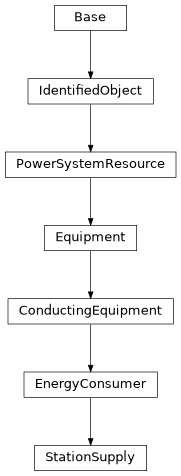cimpy.cgmes_v2_4_15.StationSupply module
- class cimpy.cgmes_v2_4_15.StationSupply.StationSupply(*args, **kw_args)[source]
Station supply with load derived from the station output.
Documentation of parent class EnergyConsumer:
Generic user of energy - a point of consumption on the power system model.
- LoadDynamics:
Load dynamics model used to describe dynamic behavior of this energy consumer. Default: None
- LoadResponse:
The load response characteristic of this load. If missing, this load is assumed to be constant power. Default: None
- p:
Active power of the load. Load sign convention is used, i.e. positive sign means flow out from a node. For voltage dependent loads the value is at rated voltage. Starting value for a steady state solution. Default: 0.0
- pfixed:
Active power of the load that is a fixed quantity. Load sign convention is used, i.e. positive sign means flow out from a node. Default: 0.0
- pfixedPct:
Fixed active power as per cent of load group fixed active power. Load sign convention is used, i.e. positive sign means flow out from a node. Default: 0.0
- q:
Reactive power of the load. Load sign convention is used, i.e. positive sign means flow out from a node. For voltage dependent loads the value is at rated voltage. Starting value for a steady state solution. Default: 0.0
- qfixed:
Reactive power of the load that is a fixed quantity. Load sign convention is used, i.e. positive sign means flow out from a node. Default: 0.0
- qfixedPct:
Fixed reactive power as per cent of load group fixed reactive power. Load sign convention is used, i.e. positive sign means flow out from a node. Default: 0.0
Documentation of parent class ConductingEquipment:
The parts of the AC power system that are designed to carry current or that are conductively connected through terminals.
- BaseVoltage:
All conducting equipment with this base voltage. Use only when there is no voltage level container used and only one base voltage applies. For example, not used for transformers. Default: None
- SvStatus:
The status state variable associated with this conducting equipment. Default: None
- Terminals:
Conducting equipment have terminals that may be connected to other conducting equipment terminals via connectivity nodes or topological nodes. Default: “list”
Documentation of parent class Equipment:
The parts of a power system that are physical devices, electronic or mechanical.
- EquipmentContainer:
Container of this equipment. Default: None
- OperationalLimitSet:
The operational limit sets associated with this equipment. Default: “list”
- aggregate:
The single instance of equipment represents multiple pieces of equipment that have been modeled together as an aggregate. Examples would be power transformers or synchronous machines operating in parallel modeled as a single aggregate power transformer or aggregate synchronous machine. This is not to be used to indicate equipment that is part of a group of interdependent equipment produced by a network production program. Default: False
Documentation of parent class PowerSystemResource:
A power system resource can be an item of equipment such as a switch, an equipment container containing many individual items of equipment such as a substation, or an organisational entity such as sub-control area. Power system resources can have measurements associated.
- Controls:
Regulating device governed by this control output. Default: “list”
- Location:
Location of this power system resource. Default: None
- Measurements:
The power system resource that contains the measurement. Default: “list”
Documentation of parent class IdentifiedObject:
This is a root class to provide common identification for all classes needing identification and naming attributes.
- DiagramObjects:
The domain object to which this diagram object is associated. Default: “list”
- description:
The description is a free human readable text describing or naming the object. It may be non unique and may not correlate to a naming hierarchy. Default: ‘’
- energyIdentCodeEic:
The attribute is used for an exchange of the EIC code (Energy identification Code). The length of the string is 16 characters as defined by the EIC code. References: Default: ‘’
- mRID:
Master resource identifier issued by a model authority. The mRID is globally unique within an exchange context. Global uniqueness is easily achieved by using a UUID, as specified in RFC 4122, for the mRID. The use of UUID is strongly recommended. For CIMXML data files in RDF syntax conforming to IEC 61970-552 Edition 1, the mRID is mapped to rdf:ID or rdf:about attributes that identify CIM object elements. Default: ‘’
- name:
The name is any free human readable and possibly non unique text naming the object. Default: ‘’
- shortName:
The attribute is used for an exchange of a human readable short name with length of the string 12 characters maximum. Default: ‘’
Inheritance Diagram:
